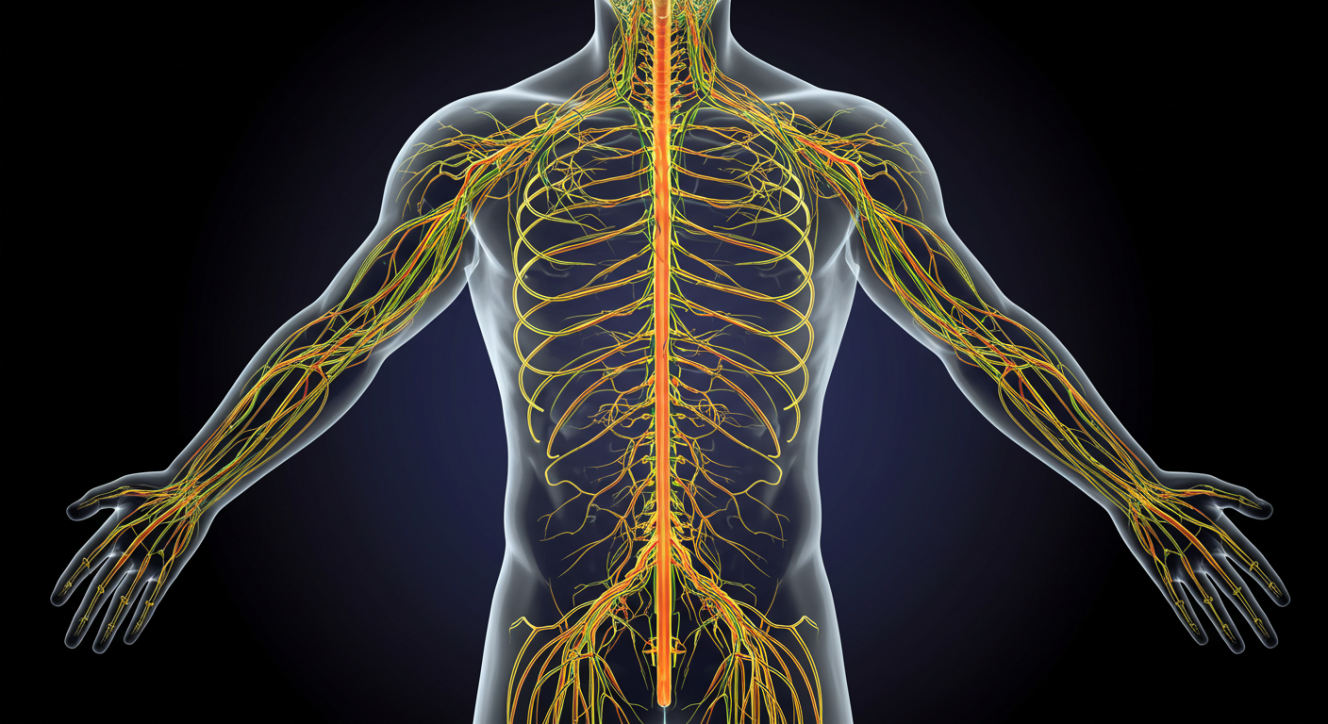Beyond Fine-Tuning

The previous article on fine-tuning explores how the essential elements for the creation and sustenance of life are abundant, and presents some of the evidence that they are also intentionally precisely calibrated.
This section delves much deeper.
Life is not merely about existence or survival: in favourable conditions, we find life to be enjoyable, purposeful, dynamic, and fulfilling. But why is that?
Could the evolutionary belief in the "survival of the fittest" provide for the diverse and complete natural comforts and pleasures of human life?
Consider this: Did you know that the human body contains so many pervasive microscopic nerve fibres, that if you were to take the interconnections in the brain alone and lay them all out end-to-end, they would encircle the earth more than four times over — and that's just one brain in one person!

But now consider this:

The body’s nervous and digestive systems are remarkably balanced for maximum efficiency, comfort, and quality of life!
For example, at one end of the digestive system, the mouth, there are highly sensitive taste buds that enable us to really enjoy the many diverse flavours of delicious food — scientists believe that our senses can detect and distinguish between more than 100,000 distinct tastes!
By contrast, at the opposite end of the digestive system, this sensitivity is, thankfully, considerably toned down; even so, our bodies can nevertheless detect precisely when it is time to evacuate waste, even conveniently distinguishing between air, solids, and liquids — but that is the extent of the sensitivity, namely exactly what is required and no more!

Another contrast is found In between these locations, within our abdomen, where the sensitivity is — by design — lowered even further so that we do not (thankfully), under normal conditions, feel the discomfort of the food passing through our internal organs.

The entire 7 metres (22 feet) length of the digestive system, then, features multiple regions with varying degrees of precisely calibrated sensitivity that ensure maximum comfort and even enjoyment, while retaining necessary sensitivity to pain, while we go about enjoying our daily lives.
Also, consider this: Why do creatures actually have bladders and rectums? It may seem like an odd question, but think about it: Without these organs, we would experience significant discomfort, as we would be forced to expel waste continually every few minutes. But would this be fatal?
Not so pleasant, though, when you're trying to enjoy some sleep!
But would a blind, purposeless process of evolution "care" about that?
Would a creature that has survived because it is the “fittest” and “strongest” care if it expels its waste constantly? And even if it did in some way "care," by what means could it intentionally commission the growth of extra organs to bring the required comfort?
It is significant that the existence of such convenient systems is replete throughout the animal kingdom. And the quality of life is thereby enhanced considerably.
A question not often seen when evolution is under scrutiny is: Where is the evidence for partially-developed body organs and their successful functionality? Supporters of evolution emphasize their belief that changes took place gradually over considerable time. How did body organs provide adequate functionality on behalf of the body during every stage of this long process?
So the study of gradual changes in body organs, and their usefulness at every stage, surely has to be a key question!
There are many theories involving this; but where is the empirical evidence?
Textbooks that teach evolution often showcase images of creatures from different classes with very different anatomies, claiming that these illustrate evolutionary changes in organ functionality or major anatomical shifts. However, these examples represent significantly differing examples and do not provide evidence of gradual transitions.

Take into account the complete set of requirements for the human body's digestive system and its associated organs: mouth, tongue, teeth, jaw, throat muscles, oesophagus, stomach, liver, pancreas, small intestine, large intestine, rectum . . . to name them in order of functionality (selecting only the major ones). How could all of these organs function adequately, or at all, if they were only partially developed or, as evolutionists put it, "in a transitional state"?
Did they really arrive gradually, or was the body's ability to obtain nutrition planned?
Did you know that the human body does not require all of its organs to sustain life? Take the gall bladder, for instance. While it is not essential for survival, it does significantly enhance the quality of life (as I can personally attest). So why would evolution, with its "survival of the fittest" mantra, "care" about that?
Another example is the stomach. Without it, we could still survive, but we would then need to continuously eat small amounts of food. Therefore, the presence of a stomach enables us to enjoy a hearty meal, followed by relaxation, while our bodies get on with the task of digestion and assimilation. Does that indicate thoughtful planning to you?
And of course, time and web space would fail me if I continued at length with other similar arguments, including numerous aspects of the world around us that enhance the quality of our lives; but here are just a few additional thoughts:
- Why do you suppose we have eyebrows? Are they essential? Similarly, why do we have eyelashes? Could we not live without them?
- Why are the tear glands conveniently situated in the top outer corners of our eyes for maximum cleansing efficiency — and the receiving tear ducts perfectly placed in the inner lower corner? Why are they even there at all? Are they essential for survival?

- Why would you say we have fingernails? Yes, they serve some creatures well when digging for food among other uses, but we could easily remain alive without them! And again, if some early ancestors of ours figured out how useful claws or nails would be in their food forays, how would they manage to alter their own anatomy — and their DNA — to grow and maintain the intended enhancements?
- Alternatively, could such "enhancements" arrive by "natural selection"? If so, they would first need to grow or mutate by chance, so that they are then available for "selection"! Digging and scratching may cause calluses on the fingers, but they could not account for the elegant shape and design of our convex, neatly positioned, useful, and attractively proportioned nails.
- The arrangement of nails on the tips of our five fingers, each conveniently fashioned with identical useful properties with the above mentioned immaculate, consistent form and arrangement, is evidence of design, not chance! (Compare the discussion on the arrangement of teeth in the section 'Where Did Those Pearly Whites Come From?')

- Why do you think we have opposable thumbs? Could we not manage to survive without them? And note especially that humans are the only creatures on earth to have them!
- Why do all humans normally have precisely five conveniently balanced fingers on exactly two hands? Did evolution not "select" from undirected appendage growths of any random quantity? Or did it somehow intentionally plan it that way?
- Why is the human body so carefully shaped and equipped for walking, which is the most energy efficient means of getting about?
And we have not yet scratched the surface of similar considerations, nor have we barely begun to venture out to nature around us, to the earth, the sun, galaxies, along similar lines of reasoning, from the marvels of the human body to other objects. For example, the earth seems to fulfil some of the criteria for a living, breathing organism: it regulates its own temperature, protects itself from most (surviving) meteors and from harmful solar radiation and magnetic storms, it uses and replenishes energy, it also recycles everything it uses, and continuously repairs its skin and its water systems.
Earth is most certainly an ideal environment for life!
(That is, until "intelligent" humans arrived and have by now virtually ruined it!)

And so on, ad infinitum. . . .
All of these considerations, too many to list in practical terms, underscore the intentional precise tuning of the universe, of the earth, and of life.

Which brings us to the image above, and to the favicon associated with this website. Each plate in this illustration is delicately balanced, yet any slight adjustment can influence the entire arrangement. Similarly, altering any of the 'finely-tuned' elements discussed here could lead to a universe incapable of supporting life, or one where life is unbearably uncomfortable.
Having read the above, take another look at Richard Dawkins' discussion, in his book, regarding his machine with six buttons as discussed in the article A Universe Fine-tuned For Life.
The universe and the natural world, the earth and life upon it, all share one overriding and striking characteristic: beauty.



Copyright © 2024, 2025, Michael A. Barber, Designomics™ — All the text and the images on this website are protected by copyright laws in multiple countries. All rights reserved.
Note: This site was created with the MyWebSite system from ionos.co.uk, including its AI capability, and with some images generated by the Copilot AI system.
We need your consent to load the translations
We use a third-party service to translate the website content that may collect data about your activity. Please review the details in the privacy policy and accept the service to view the translations.
